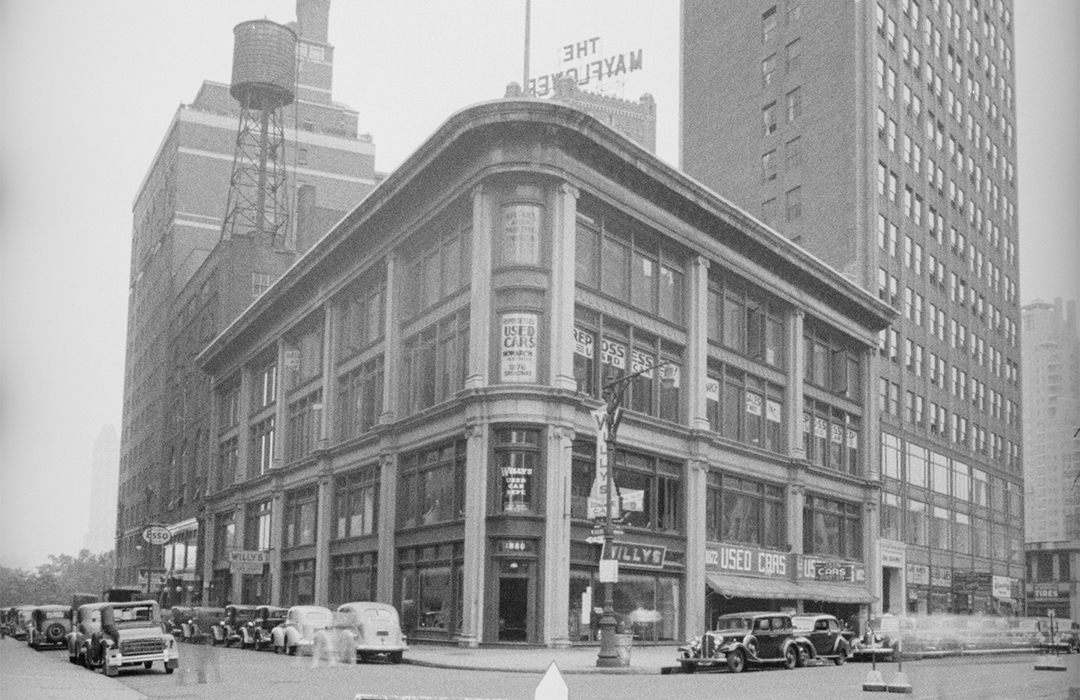
The New York Guild for Jewish Blind — 1872-1880 Broadway
by Tom Miller
When John D. Wendel died in 1876, he left a fortune and vast real estate holdings. His son, John Gottlieb Wendel, managed the family properties as the Wendel Estate.
In the first years of the 20th century, Broadway from Times Square to 72nd Street was known as Automobile Row—lined with vehicle showrooms, garages, and retailers who dealt with accessories-related automobile items. In July 1905, Henry C. Hollwedel, who had been the Wendel Estate’s in-house architect since 1896, filed plans for a “brick and stone automobile garage” at the southeast corner of Broadway and 62nd Street. The construction cost was projected at $150,000, or about $5.3 million in 2025 terms.
In dealing with the acute point of the triangular plot, Hollwedel gently chamfered the building’s corner. Even the windows conformed to the curved design. Designed in an industrial take on Renaissance Revival, the four-story structure was visually divided into two horizontal sections, each dignified with double-height Ionic pilasters.
Henry C. Hollwedel, who had been the Wendel Estate’s in-house architect since 1896, filed plans for a “brick and stone automobile garage”
Among the first tenants to move in was the showroom of The Royal Tourist Car Co. In October 1909, it advertised its new Model “M” Series with superlatives. “It is noiseless, faultless, matchless, powerful, luxurious, efficient, unsurpassed for riding and unapproached in design—but the sum of its virtues is expressed in two words—unequalled service.”
By 1912, the Ranier & Lineburg Co. occupied space here. Among its models available in 1914 were the Willys-Knight, the Garford, and the Willy’s Utility. Sharing the building that year was the Marmon Auto Company on the ground floor and the National Auto Repair Company on the third.
The Marmon Auto Company would remain well into the 1920s, selling both new and used vehicles. An advertisement in the New York Evening Post in March 1922, offered a 1920 Marmon Model 84 sub-sedan for $4,000, and a 1918 town car with “special body” for $2,500. Even previously owned Marmon cars were expensive. The prices would translate to $72,700 and $45,400 today.
Around 1929, Stutz New York Company, Inc. moved into the building. Like its predecessors, its well-known vehicles–the Stutz and the Blackhawk–were high-end automobiles. A Stutz was advertised in January 1929 for the staggering price of $6,895. The company remained here into the 1930s, the height of the Depression.
The building was renovated in 1944 for the New York Guild for the Jewish Blind, founded in 1914. On June 28, The New York Times reported, “A ‘City Center’ for blind persons housing the occupational, recreational and employment facilities of the New York Guild for the Jewish Blind was dedicated yesterday at 1880 Broadway.” Where luxury automobiles had been displayed, there was now an auditorium, and the upper floor offices had been converted to classrooms, shops and activities spaces.
The building was renovated in 1944 for the New York Guild for the Jewish Blind, founded in 1914.
Leonard M. Wallstein, the head of the guild, explained the larger quarters would “house all its activities and workshops under a single roof.” He said the guild’s purpose was “to train our blind employees while they are earning and receiving self-respecting and self-sustaining wages that they can promote the education of private employers to the realization that blind workers have an economically appropriate place in competitive industry.”
A new facility within the building opened on October 11, 1954, with a nursery school. Although the name had not been changed, by now, the New York Guild for the Jewish Blind was nonsectarian, accepting “visually handicapped of all ages, races, and faiths,” according to Bernard J. Lasker.
The New York Guild for the Jewish Blind remained in the Broadway building until 1971, when it moved into its newly built structure at 15 West 65th Street. Henry C. Hollwedel’s 1906 automobile showroom building survived until the first years of the 21st century, replaced by a 36-floor apartment building.
Tom Miller is a social historian and blogger at daytoninmanhattan.blogspot.com


